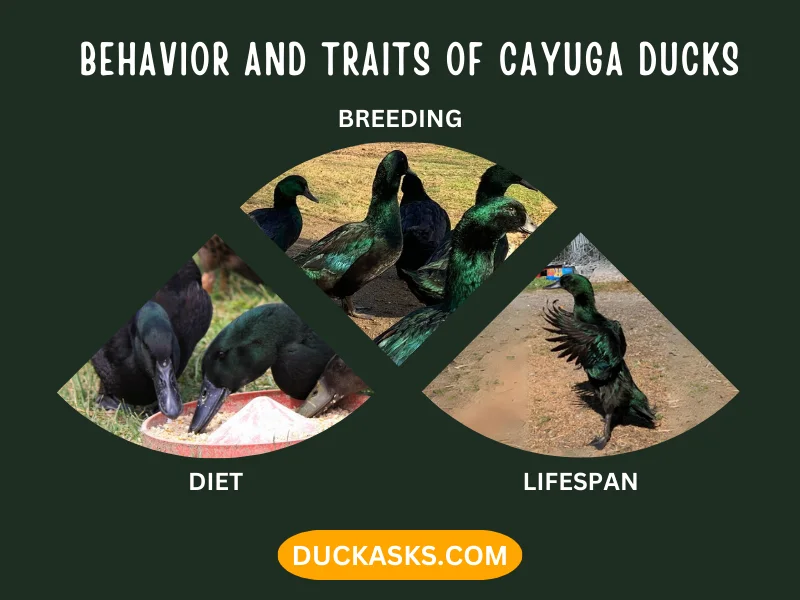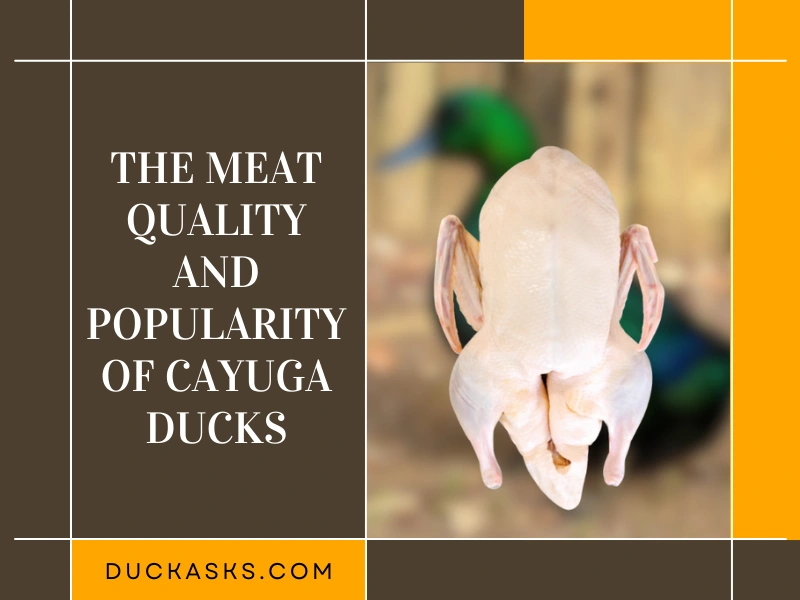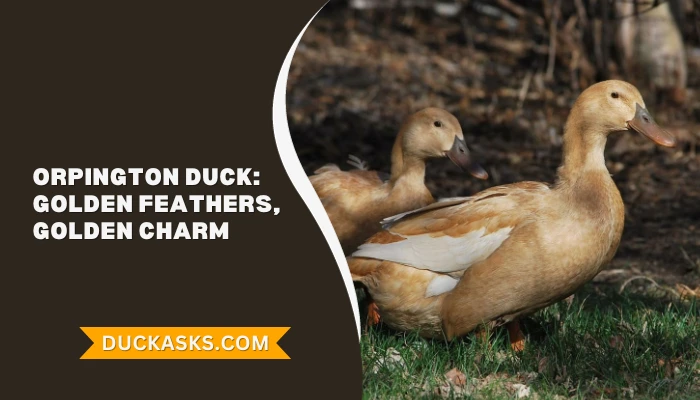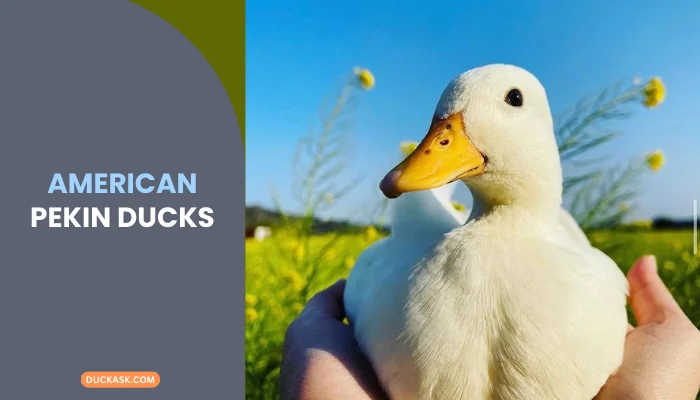Cayuga Duck: History And Breed Guide
The Cayuga is a domestic duck breed that happened to provide the most popular meat before the Pekin duck surpassed its popularity. Nowadays, farmers breed and raise Cayuga ducks for their meat, eggs, and even their looks for ornamental purposes.
But how do you breed the Cayuga duck successfully? In this article, we will explore everything you must know to breed and raise this duck. We will also address common concerns like the diet, how to feed them, and what to do to increase breeding success.
Want to know more about the Cayuga duck? Stick around and find out how to make the most out of it!

Looking for more articles about duck breed:
Cayuga Duck Profile
| Name | Cayuga Duck |
|---|---|
| Scientific Name | Anas platyrhynchos domesticus |
| Common Names | Cayuga Duck, Cayuga Black Duck |
| Origin | New York, United States |
| Size | Medium to large |
| Weight | 7 to 8 pounds |
| Lifespan | 8 to 12 years |
| Feather Color | Black, featuring iridescent hues |
| Climate Tolerance | Elevated |
| Behavior | Calm and docile |
| Special Features | Dark bills, legs, and feet of black color |
| Breeding and Maintenance | Easy |
| Easy to Keep? | Yes |
| Duck Purpose | Eggs, meat, ornament, and fishing flies |
| Egg Productivity | 100 to 150 eggs |
| Rarity | Yes |
Overview of Cayuga Ducks
The Cayuga duck is a domestic duck primarily used for meat and egg productivity. However, another occasional use includes ornamental due to their unique appearance. Anglers also use the feathers to tie fishing flies, but this application is less common.
History and Origins of Cayuga Ducks
The origin of the Cayuga duck is unclear. Over the years, one of the most popular theories is that this duck is the result of two wild ducks paired by a miller in New York in 1809.

Nonetheless, no documentation backs up this theory. Another theory suggests that Cayugas developed from wild ducks in the region of New York, but there are no records to support this theory either.
But one thing is clear, and that’s that this duck was introduced to the Finger Lakes in New York around 1840 by John S. Clark. In fact, the breed allegedly received its name in honor of the indigenous Cayuga habiting the region.
Since then, the Cayuga duck has gone through plenty of historical milestones. In 1874, the breed appeared in the first American Standard of Perfection edition.
It was introduced to the United Kingdom in 1851, and the Cayuga duck became the primary duck raised for meat consumption in countries like the United States.
Eventually, the American Pekin would rise in popularity and displace Cayuga.
Physical Characteristics and Features
Cayuga ducks are medium to big ducks, with the drake weighing approximately eight pounds and the ducks weighing seven pounds.

The breed has black plumage featuring lights of an iridescent bettle-green color. Over time, the feathers of Cayuga ducks can fade or lighten up to a white color as they age. When this situation occurs, the duck is no longer eligible for showing or decoration contests.
On the lower part, the ducks have black bills, legs, and feet. The eyes have a dark brown color.
Here’s a breakdown detailing every detail.
| Characteristic | Description |
|---|---|
| Size | Medium |
| Height (size) | Slightly above average |
| Weight | Drake: 3.6 kg, Hen: 3.2 kg |
| Legs | Long and robust |
| Heads | Long and finely formed |
| Bills | Long with a slightly depressed top line |
| Eyes | Full, dark brown color |
| Colors | Black, iridescent color |
| Personality Traits | Friendly and quiet |
| Purposes | Egg and meat production, exhibition |
| Incubation Period | 28 days |
| Lifespan | 8 to 12 years |
Differences Between Cayuga Ducks & Cayuga Drakes
Cayuga ducks and drakes have several differences to tell them apart. For example, the female ducks are smaller in size and weigh a pound less approximately. Similarly, female Cayugas are often louder than males. While hens make clear quacks, males have deeper and quieter quacking.
Let’s address these differences more clearly.
| Characteristic | Cayuga Drake | Cayuga Hen |
|---|---|---|
| Weight | About 3.6 kg (8 Pounds) | About 3.2 kg (7 pounds) |
| Feather Color | Black and green, with a dark sheen | Black and green, with a dark sheen, more likely to fade or turn white over time |
| Sound | Deep and quiet quacking | Loud quacking |
| Feather Style | Curled and hard tail feathers after 90 days since birth | Average |
| Behavior | Shows mounting and mating behaviors once it’s four months old | Become broody |
How Can You Tell If a Cayuga Duck Is Male or Female?
You can tell if a Cayuga duck is male or female by looking at their physical traits and behavior. While both genders are calm, their personality during mating season changes drastically.

The males get more confident and bold, whereas the females display usual broody traits like hiding.
Another method to identify the gender of your Cayuga duck is by listening to their vocalization. Male Cayuga ducks quack quietly, and they have a raspy voice.
On the other hand, female Cayuga ducks quack louder and more clearly.
Behavior and Traits of Cayuga Ducks
The personality of a Cayuga duck is friendly and quiet, especially if you raise it since it is a duckling. However, adult ducks will not be a problem at all.

With proper training, they will react to your calls and come running to you if you use treats as an incentive.
Diet
Feed your Cayuga duck with commercial duck food to ensure they receive all the nutrients and vitamins to grow healthy.
Other than that, the foraging sense of this duck breed will allow it to search for snails, slugs, and different insects. If these are not present in the vicinity, you can include them as treats in their diet.
Another thing to consider is the purpose of the duck. If you want healthy duck eggs, you must feed the ducks with quality formulated duck.
Additionally, a constant water supply should also be present to help them eat without choking risks.
Breeding
While Cayuga ducks reach their adult size at 12 weeks old, they will start laying eggs only when they’re five months old. This can happen any time of the year, as this duck breed can produce eggs year-round.
Typically, the hens choose mating partners each season instead of finding a partner for life. On average, this duck will lay around three eggs weekly, but the total number can vary.
After mating, Cayuga ducks sit and hatch the eggs, taking 28 days total. In this stage, the mothers can become broody and be overly protective of the nest.
The offspring will need special care during their first days. You can raise them outside, within a proper shelter with dry and warm areas to sleep.
It’s necessary to keep the ducklings away from the cold and rain during this period.
One thing to consider is that you must separate the ducks from their parents once they reach maturity. Sometimes, the drake may try to mate with them, which could be fatal.
Lifespan
The average lifespan of Cayuga ducks is between eight and twelve years. Naturally, good food and proper living conditions will ensure that ducks live longer.
As long as you meet these essential requirements, your Cayuga duck will be overly productive.
Breeding and Raising
Successfully raising Cayuga ducks will depend on several factors. You must know how to select the mating pair, when to feed them, and what to do during the mating season. Here’s what you need to know.

Some Tips and Considerations for Successful Breeding
- Buy your ducks from a renowned seller. Avoid dealing with sketchy sellers or farmers, and don’t spare on prices. Quality breeding will depend on whether or not the mating pair is healthy and in good condition.
- The ducks may display unique behavior during mating season. For example, they may start or peck more often. Once you notice these signs, allow them to mate without intervening.
- Remove ducks from the flock if you spot illnesses or odd behavior.
- Try avoiding inbreeding. This situation will lead to health issues and fewer eggs laid.
Feeding and Housing Requirements
A proper shelter is necessary to keep the ducks enclosed but also to keep predators away. In this case, you can build a duck house or a coop.
Ideally, the minimum requirement is three square feet of floor space per duck. Also, the housing must be tall enough that the ducks can spread their wings comfortably.
Similarly, the ducks will require warm, dry, and comfy bedding within the shelter. Outside, you can set up a fence for more protection and add features like small ponds to entertain the ducks.
Feeding
You should feed your Cayuga ducks twice per day. Start with a small portion in the morning, then provide more food for the second time later that day.
If you notice plenty of leftovers the following day, reduce the amount. Avoid overfeeding and keep the area clean.
The Egg Productivity of Cayuga Ducks
Over a year, the Cayuga duck can lay between 100 and 150 eggs. The eggs are large and start as black initially. However, the color lightens and becomes whiter over the season.
The eggs of Cayuga ducks are very healthy, with delicious yolks and a thick consistency. As a result, these eggs are suitable for general cooking and baking applications.
The Meat Quality and Popularity of Cayuga Ducks
The meat quality of Cayuga ducks is high. In fact, this duck was once the most popular in countries like the United States and England due to its delicious taste.

While the Pekin duck surpassed its popularity, the Cayuga duck remains one of the most flavorful duck meats.
Cayuga duck meat has a distinct flavor, often compared to prime beef. For this reason, you can find dishes offering Cayuga meat in restaurants all over the big cities.
This is beneficial if you’re a farmer, as it presents another business opportunity while raising this duck.
Why Did the Pekin Duck Surpass the Cayuga Duck in Popularity?
Different reasons contributed to the fall of the Cayuga duck’s popularity in favor of the Pekin Duck. Primarily, the Pekin duck has larger breasts and is faster to gain weight.
Another potential reason is that removing the feathers of Cayuga ducks is more challenging.
Frequently Asked Questions
- Will Cayuga ducks fly away?
No, Cayuga ducks are not likely to fly away because their flight skills are poor. You must still secure the perimeter to keep predators away, but special accommodations are unnecessary if you worry the duck may fly away.
- Are Cayuga ducks messy?
Cayuga ducks can be messy. Since they enjoy playing with water, these ducks usually spill water bowls around. Clean the area regularly to prevent excessive moisture.
- How much are Cayuga ducks worth?
The price of the Cayuga duck is between $8 and $16. Males start at $8, whereas females start at $15.
Conclusion
The Cayuga duck is an all-around duck that you can use for different reasons.
Do you like fancy birds? Then, the Cayuga is a good-looking species with unique physical traits. If you’re more focused on egg or meat productivity, this duck breed also provides satisfying results for those purposes.
Whether you’re a businessperson or you want to raise ducks as a hobby, the Cayuga duck is a good choice.
Stay connected with us and learn more about ducks and birds in general by visiting our socials on Twitter, Facebook, and Pinterest!
There, we keep you updated with more insightful and fascinating information about the world of birds!
REFERENCES:
- https://livestockconservancy.org/heritage-breeds/heritage-breeds-list/cayuga-duck/
- https://www.waterfowl.org.uk/domestic-waterfowl/heavy-ducks/cayuga/
- https://www.omlet.co.uk/breeds/ducks/cayuga/
Image Credit:
- https://www.instagram.com/jrg.photography/
- https://www.instagram.com/briarpatchfarm/
- https://www.instagram.com/ftv.photography/






